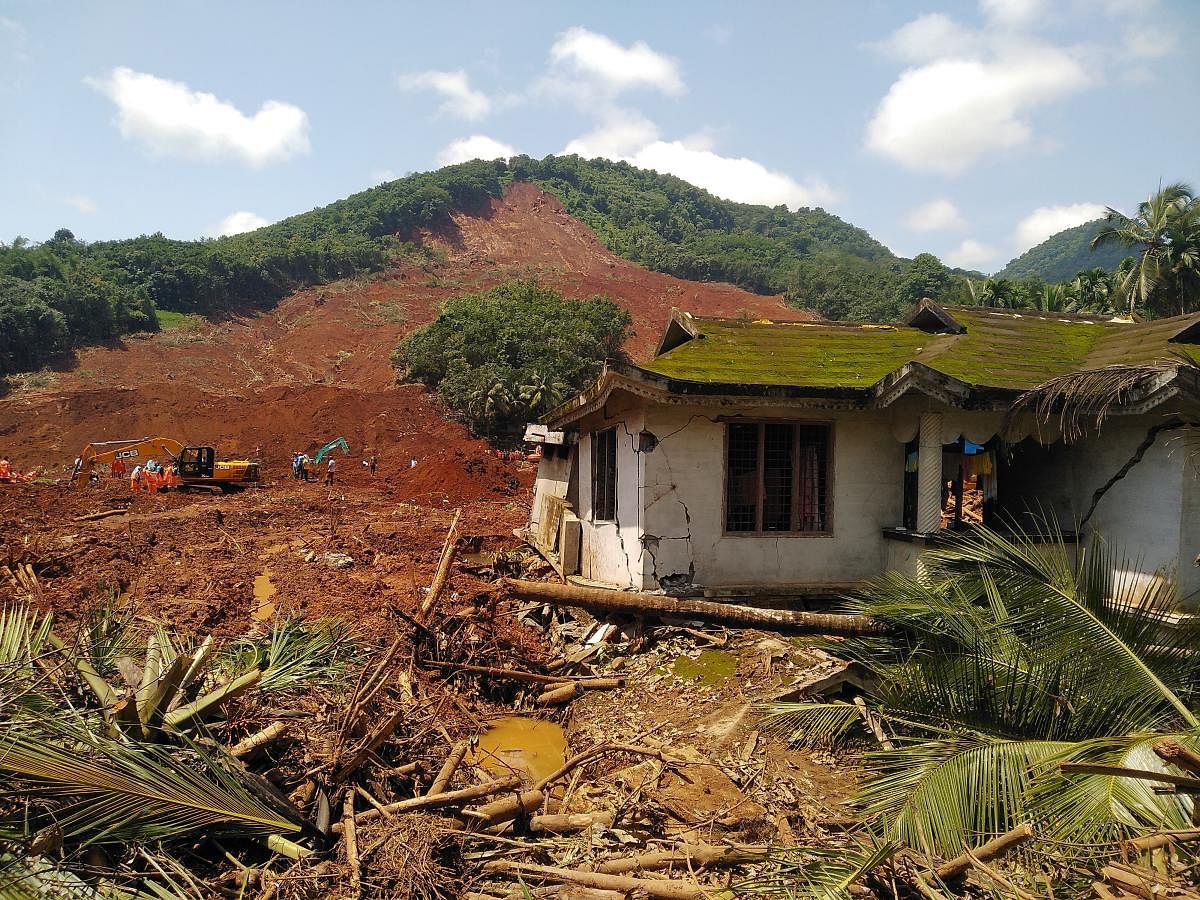
Prone to frequent floods and extreme meteorological conditions, mountain regions of South India, especially Karnataka and Kerala, have been of late rattled by large-scale landslides that have literally washed away villages and towns. While flash floods and incessant rains have got due attention of policymakers, the widespread landslides, of varying magnitude, have barely caught the public attention. Wiping out several villages in less than a few minutes leaving no trace of human existence, landslides have unleashed terror all along the Western Ghats districts and gripped the region in panic which may last for decades.
According to scientists and geologists, the landslides unlike other catastrophes such as floods and droughts in these parts of peninsular India may appear to be small. However, the slip of landmass along the valleys can be more fatal than any other disaster and may take years for the people from the region to recover. Adding to the treacherous mess, rapid erosion of natural resources and degradation of soil along the valleys not only cause irreversible environmental damage but also raze down the livelihood of thousands of people. To make matters worse, the phenomenon is only spreading from one district to the other with every passing year.
MUST READ: Maximum landslide deaths in India
llegal quarries create quandaries for Keralites
“What was seen in Kodagu and Dakshina Kannada until last year has now struck Chikkamagaluru as well. The sudden deluge in Alekhan Horatti, Kalasa and Kottigehara villages is shocking. But it is not something new and has been showing its signs for several years. The tragedy is that all of us, including the state government, have failed to sense it,” said Ananth Hegde Ashisara, former chairperson of Western Ghats Task Force.
“Even in Kodagu, an assessment was done and reports were submitted by geologists. But the issue never progressed beyond the realm of these theoretical approaches. We must act at least now when the very piece of earth on which we are standing is collapsing at an alarming speed,” he added.
The task force had submitted over 50 region-specific reports to the state government almost a decade ago.
While the landslides along the National Highway and mountain railway network have come to the fore, hundreds of landslides deep inside the densely forested region have gone unnoticed, according to experts from Indian Institute of Science (IISc), Bengaluru. As per the estimates by the Geological Survey of India, about 15 to 20 per cent of India’s landmass is vulnerable to landslides. “Even though the Western Ghats is termed as the most stable region, of late due to rampant degradation of forest and valleys, it has also become vulnerable to landslides. While human intervention is the primary reason, varying rainfall pattern resulting in the loosening of landmass has only added considerably to the cause,” opined a geologist from Bengaluru.
“Today’s landslides all along the Western Ghats are the result of what we did in the region over the past two to three decades. It was often argued that landslides were only reported along the Konkan coast due to railway and road widening, it has begun to strike deep inside remote areas where no works have been taken up in the past 10 years. But at the same time, these areas witnessed large-scale clearing of forests to raise plantation and carry out other anthropogenic activities which are now resulting in landslides,” Ashisara clarified.
Evidently, the fragmented forest patches in all these districts suffered heavy landslides. Prof TV Ramachandra of Centre For Ecological Sciences, IISc, said, “The fragmentation has a wide-scale influence on the movement of soil (silt) and debris along the undulating terrain with heavy rainfall. This loose deposition on unstable slopes along with scanty vegetation cover will lead to landslides.”
S Chandrashekar, chairperson of the Western Ghats Task Force, said, “Landslides in the Western Ghats is due to large-scale deposition of dug up debris and loose soil. Be it the widening of road works, irrigation projects, tourism activities, these works resulted in excavation and dumping of loose soil along the steep slopes. As the area receives heavy rainfall, the loose soil dumped along these valleys gets washed away affecting the stability of the region.”
“The likelihood of landslide and landmass slip is three-fold more in the areas disturbed by linear infrastructure as compared to undisturbed steep forests,” detailed a study report by IISc experts submitted to the government in 2018.
Multiple factors
Unlike other disasters which are triggered by a key factor, landslides are due to multiple factors spread over a long range of time. “In the initial stage, the natural stability of the slope along a valley gets affected due to varied anthropogenic activities. The instability could be due to deterioration of soil resistance and change in land use causing slope instability. These cracks begin to widen and slide when water (rain) collects in the ground and results in a surge of water-soaked rock, earth and debris resulting in the final movement of the landmass,” highlighted the IISc report in 2010 on ‘Landslide susceptible locations in the Western Ghats’.
Experts argue that scientists and researchers had predicted these damages almost a decade ago. “The IISc team comprising Prof TV Ramachandra, Prof M D Subash Chandran and others has been studying the hilly regions since 2000 and have submitted recommendations to successive governments. But the reports and recommendations continue to remain in the closet as no government has any interest in it. Unlike the populist programmes, these works do not bring any money or fame to the political bosses,” bemoans Chandrashekar whose report on status and future of Western Ghats is gathering dust.
Forecasting that the incidents of landslides continue to shoot up in the coming days, experts have cautioned the state government to put in place redressal mechanisms.
“Natural disasters have drastically increased over the last decade. The trend of increasing incidences of landslides is expected to continue in the next decades due to urbanisation, continued human activities, deforestation for various linear projects and increased regional precipitation in landslide-prone areas due to changing climatic patterns. The application of modern technologies required to control the effects of natural hazards including landslides must consider three significant factors — prediction, monitoring and conservation,” says Prof Ramachandra.
Ashisara expresses, “The government must not allow any clearing of forests along the slopes. There shall also be regulation on large-scale farming by corporates and investors who not only affect the angle of the slope but also deposit loose soil and debris along the slope damaging the terrain. In fact, in the recently held convention at Hariharapura near Sringeri, we resolved to exert pressure on the government to regulate earth movers and their uses.”
Ecologists urge for a complete ban on developmental activities in these regions to save ecosystems from complete destruction.
